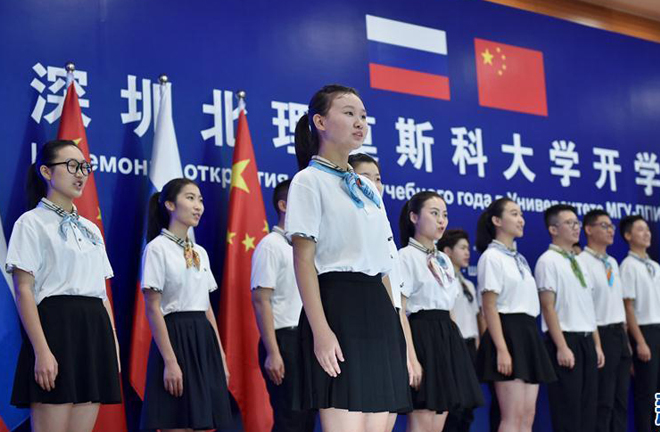‘B&R’: A new framework for China-Russia exchanges

A student chorus sings the song Katyusha at the inauguration ceremony of Shenzhen MSU-BIT University, held in Shenzhen, Guangdong Province on Sept. 13. Co-founded by Beijing Institute of Technology (BIT) and Lomonosov Moscow State University (MSU), Shenzhen MSU-BIT University will enhance cooperation between the two countries in technology, education, economy and culture. (PHOTO: XINHUA)
The fifth Annual Meeting of the Association of Sino-Russian Economic Universities was recently held in Jinan, Shandong Province. On the basis of two national strategies —China’s Silk Road Economic Belt and Russia’s Eurasian Economic Union (EEU)— scholars explored the opportunities and risks of cooperation on regional economic and educational issues as well as the humanities.
The circle of friends for the “Belt and Road” initiative has been gradually expanding ever since Chinese President Xi Jinping proposed it in 2013. Explaining this phenomenon, scholars at the meeting reached a consensus that the “B&R” initiative conforms to the trends and demands of global development.
Global trade has been in a slump since the global financial crisis in 2008, and the world needs a new investment opportunity to overcome long-term stagnation, said Sun Jie, a research fellow from the Institute of World Economics and Politics at the Chinese Academy of Social Sciences. By connecting Asia and Europe, the initiative helps new investment flow into the infrastructure of participating countries, Sun said. The new markets established through connection and integration will increase demand and encourage economic development by providing capital and investment to meet the growing demand, he said.
The “B&R” initiative fully addresses the development needs of countries and areas along the routes of the initiative. Zhao Zhongxiu, vice president of the University of International Business and Economics, said that China and Russia are friendly neighbors and important strategic partners in global integration. The China-Russia relationship is the model for healthy, stable and mature relations between countries, Zhao said. Russia is an active supporter, important participant and crucial partner of the “B&R” initiative.
The joint statement signed by Chinese President Xi Jinping and Russian President Vladimir Putin in 2015 on the alignment of the Silk Road Economic Belt initiative and the EEU blueprint showed the two nations’ determination to establish a community of shared destiny, broaden the space for bilateral strategic cooperation and inject new momentum into China-Russia relations, Zhao said.
The 19th National Congress of Communist Party of China designed a development strategy for China’s future development, which set clear goals for revitalizing China’s economy and improving people’s living standards, said Vladimir Shamakhov, director of the North-West Institute of Management at the Russian Presidential Academy of National Economy and Public Administration.
In terms of China’s foreign trade, the congress also proposed a new pattern of overall opening-up, Shamakhov said. More than 100 nations and international organizations have participated in the “B&R” initiative since it was proposed. Chinese enterprises have created more than 180,000 jobs in related areas, he said. The joint statement facilitates the alignment of the national strategies of the two nations, deepening practical cooperation, he said.
China has closely cooperated with the Eurasian Economic Commission (EEC) in the past two years, Shamakhov said. The Supreme Council of the EEC started negotiations with China recently and further strengthened plans for alignment cooperation, he said, adding that China has also reaffirmed its commitment to constructive cooperation with EEU.
ZHANG QINGLI is a reporter at the Chinese Social Sciences Today.
